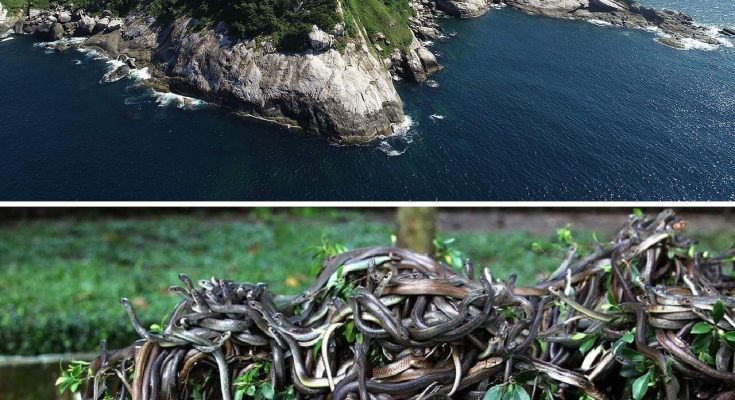Off the coast of Brazil lies an island so treacherous that the government has made it completely off-limits to human visitors. Known as Ilha da Queimada Grande or Snake Island, this 106-acre island is home to one of the most venomous snakes on the planet: the golden lancehead viper. With an estimated population of 2,000 to 4,000 snakes, it’s believed that there is one venomous snake for every square meter of land. The dangerous serpents and the island’s fascinating isolation make Snake Island one of the most unique – and deadly – places on Earth.
The Hidden Danger of Snake Island
Just 21 miles off the southeastern coast of Brazil, Snake Island’s reputation is well-earned. The island is an eerie habitat for Bothrops insularis, the golden lancehead viper. What makes this snake so perilous is its venom – five times more potent than that of its mainland cousins. A bite from one of these vipers can cause kidney failure, internal bleeding, and death within an hour if left untreated. Due to the lack of natural predators and the high number of venomous snakes, the risk of encountering one is shockingly high. In fact, it’s not uncommon for visitors to encounter a snake every few meters while traversing the forested areas of the island.
The Mysterious Origins of Snake Island
The story of Snake Island dates back approximately 10,000 years, when rising sea levels at the end of the last ice age cut off a small piece of land from Brazil’s mainland. This isolation allowed the golden lancehead viper to evolve into a much more dangerous species than its mainland relatives. Without any land-based prey, these snakes adapted to hunt birds, developing venom that works quickly enough to paralyze and kill their flying prey before they have a chance to escape.
The Deadliest Population on Earth
Though the island’s size is small, its snake population is dense. Estimates suggest there are 1-2 snakes per square meter of land. This staggering density makes it one of the most dangerous places on Earth, as the venomous snakes are never more than a few feet away. The rapid evolution of the golden lancehead on Snake Island has led to a remarkable adaptation: the snakes’ venom is not only more potent but also more specialized, designed to subdue and immobilize their avian prey.
A Deadly Legend: The Lighthouse Keeper’s Last Stand
One of the most chilling aspects of Snake Island is the local legend surrounding its last lighthouse keeper. In the 1920s, a family of lighthouse keepers was said to have been overwhelmed by the island’s snake population. The story goes that snakes crawled through the windows of their home, and in their desperate attempt to escape, the family was fatally bitten by the golden lanceheads hanging from branches. While the truth of this eerie tale remains unverified, it highlights the island’s notorious reputation. The lighthouse is now automated, and the Brazilian Navy only permits rare visits for maintenance.
The Black Market: A Deadly Trade
Despite the island’s danger, Snake Island and its golden lancehead vipers have attracted the attention of illegal traders. The potent venom of the golden lancehead shows promise in heart disease treatments, sparking a black market demand for these venomous snakes. As a result, Snake Island’s population has become critically endangered, and illegal poaching has exacerbated the threat to the species. Only licensed scientists and researchers are allowed to visit the island, and they must do so with extreme caution.
The Future of Snake Island
The golden lancehead viper’s future remains uncertain. Aside from illegal poaching, the species faces additional threats, such as habitat destruction, inbreeding due to the island’s small population, and disease. Despite these challenges, the golden lancehead’s isolated habitat remains largely untouched, preserving it as one of the most fascinating ecosystems in the world.
Today, Snake Island serves as both a natural laboratory for scientists studying isolated ecosystems and a forbidden zone, heavily guarded by the Brazilian Navy. While the golden lanceheads’ survival is in question, the island remains an enduring testament to the power of evolution and nature’s ability to create extreme, isolated environments.
Why Snake Island Remains a Forbidden Paradise
Snake Island remains closed to the public for a variety of reasons. First and foremost, the risk to human life is significant. The golden lancehead’s venom is incredibly potent, and the island’s dense snake population makes any visit to the island a potentially deadly experience. Additionally, the Brazilian government has implemented strict protections to preserve the island’s fragile ecosystem and protect its unique species from poaching.
For those who are fascinated by this deadly island, it remains one of the last places on Earth where nature reigns supreme – a place where human intervention is restricted, and survival is a matter of adaptation and evolution.



